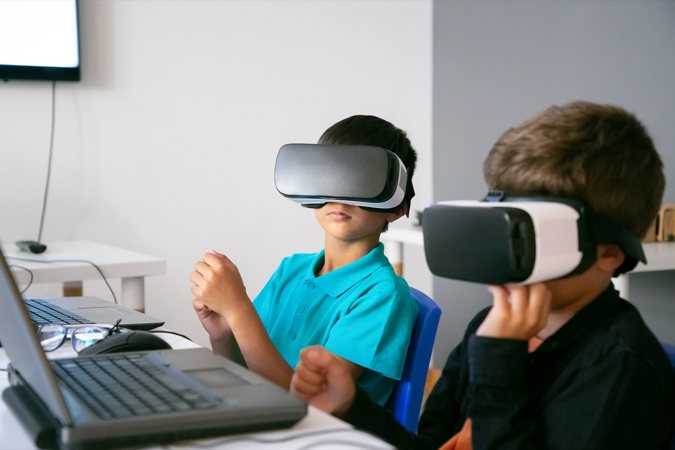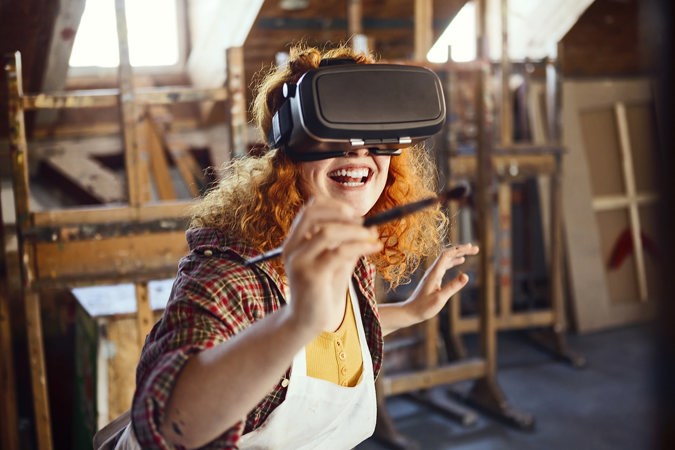VR in the classroom: benefits and drawbacks
Introduction
What is virtual reality in the context of education?
Virtual reality, or VR for short, is a simulated experience of a three-dimensional environment. The most common way to access VR is through a virtual reality headset, such as the Meta Quest, the Sony PlayStation VR, or the Apple Vision Pro. Virtual reality allows users to look around, move, and interact with their surroundings. Virtual reality has potentially endless use cases, going from virtual museum visits to letting medical students practice surgery on a virtual patient. In the case of education, VR may enable students to experience otherwise impossible scenarios, such as visiting far-away cultural sites or traveling back in time from the comfort of the classroom.
Overview of current uses and benefits
Virtual reality has many potential applications in education: besides making virtual museum visits much more immersive, it can help chemistry or biology students conduct experiments in a safe environment. Art students may see a virtual art gallery or even exhibit their creations side by side with famous paintings or in their favorite museum. With the decreasing cost of the necessary equipment, the number of potential applications for VR in education has grown enormously, and this trend is still ongoing. Virtual reality can revolutionize both how educators teach and pupils learn.
What are some potential uses of VR in education?

Science, technology, engineering, and math (STEM) education
Let's explore a few ways of applying virtual reality to STEM subjects.
In a physics class, students may simulate how gravity affects the world around us and experience first-hand what it would be like to walk on the Moon or another celestial body. Students may go for a virtual field trip to see how wind farms generate electricity or understand a particle accelerator's inner workings. In addition, students may carry out physics experiments that would be dangerous or difficult to replicate in real life.
VR could benefit engineering students by allowing an engaging way to design and prototype models at no cost. The added benefit is that many issues can be identified and fixed before building a physical prototype. VR would also be helpful when putting together a project, allowing students to visualize the assembly process in three dimensions. VR would also let students experiment with scenarios that would be unsafe or complicated to test in the real world, such as an extreme load on a bridge, and study the potential consequences of such a scenario.
Primary school students can also benefit from many virtual and augmented reality applications for STEM subjects: tools such as i3LEARNHUB let students experiment with augmented reality (AR), helping them visualize cells and organs through Lifeliqe. Lifeliqe is an educational software that helps students visualize scientific concepts such as organs or cells through augmented reality (AR). Students may also visit the bottom of a volcano or the solar system. VR can also foster collaborative learning among K-6 students, letting them work together on a project or explore a virtual space with a friend.
History and social studies
Many children and adults alike dream of being able to experience what it was like to live at the time of the Romans or how the Americas looked like in 1492. With a VR setup, it is possible! Both educational experiences and time-traveling video games allow students to experience the world as it was in the past or even how it will be in an imagined future.
Few students can afford to travel to another continent, but virtual reality can make this experience possible for most. Students can wear a headset to visit historical landmarks or monuments from the comfort of their classroom. It can also simulate different geographic regions, helping students understand what it is like to live in a different climate or continent altogether.
Using virtual reality to learn a new language
Students can use VR to learn a new language: immersion is crucial when getting to know a different culture, and virtually visiting a country and interacting with native speakers can help with immersion. Rather than exclusively studying through video or text, students can immerse themselves in a virtual environment. A potential use of VR to practice a foreign language could be ordering a coffee or a meal at a restaurant, helping the students grow more confident in their language skills while knowing they are in a safe environment and without the prohibitive travel costs.
Virtual field trips and lab simulations
As can be noticed from the previous paragraphs, an essential use of virtual reality is allowing students to go on virtual field trips at a fraction of the cost. Virtual field trips apply to different subjects and pedagogical areas, from history and geography to a completely simulated chemistry lab where students can carry out exciting experiments.
VR can also let students with physical disabilities visit places that would otherwise be impossible or difficult. Students with social disabilities may benefit from using VR, knowing they can interrupt the experience as soon as they feel uncomfortable.
The benefits of VR in the classroom

Immersive learning experiences
VR can be beneficial for students in several ways. For example, they can access real-world experiences in a variety of contexts. VR is inherently safe, as students can carry out dangerous experiments or explore challenging environments from the safety of the classroom. VR can also promote collaboration between students in ways that were impossible before.
Increased engagement and motivation
VR promotes active learning through immersive experiences in virtual environments, helping students hone their problem-solving skills. For elementary school students, VR can help improve retention and deepen engagement thanks to its immersive nature. VR benefits students who may have difficulty paying attention to traditional class lectures.
Research has shown that students are more motivated when using virtual reality in specific settings. In an article published in the International Journal of Emerging Technologies in Learning, medical students were most motivated when learning through virtual reality: it outperformed video and text-based learning settings.
For more mature students pursuing medicine, research by Stanford University has found that the empathic response triggered by an elderly patient in a 360-degree video is much more powerful than reading text from case studies. Both augmented and virtual reality can significantly affect medical students' learning, possibly altering their perspectives and way of approaching challenges in the future.
Improved retention and comprehension
By using virtual reality to assess students' communication skills, McGovern and colleagues (2019) found that using VR in specific educational settings can be beneficial and even outperform traditional teaching methods. A significant improvement in learning gains was also found in a meta-analysis by Villena-Taranilla and colleagues (2022). However, the authors point out a need for more research in VR, explaining how more studies are needed to determine the exact impact of virtual reality on education.
Accessibility for students with disabilities
Students with physical or social disabilities can find it challenging to cope with the average school environment, and however, virtual reality can help them relieve some of this discomfort. For instance, The Hechinger Report explores how students in a video production class created a virtual tour of the middle school. They aimed to allow new students to tour their future school in advance, in a low-stress environment like their home.
Other applications include touring nearby establishments, such as shops downtown, to help students prepare for independent living in the future. In addition, VR can also help some students learn how to interact with police officers and other authority figures.
Potential drawbacks of VR in education

The practical implementation of virtual reality in the classroom is an expensive process. One must consider the initial costs of purchasing the devices and the ongoing costs of training for teachers and school personnel. For this reason, schools with limited budgets may not make VR a priority.
Due to these limitations, VR technology must improve to become widely available in schools and other institutions. However, the cost of these systems has decreased as time goes by and is becoming more and more affordable.
Key stakeholders at all education levels must carefully consider how to implement VR tools in the curriculum. Understanding how VR can contribute to achieving the pedagogical goals of the lesson is a crucial aspect of successful implementation. VR needs to be part of a broader plan that includes many ways to encourage students to learn and experiment.
Something that educators and decision-makers alike need to keep in mind when using VR in the classroom is the potential for the exclusion of non-VR users. Reasons such as motion sickness and various visual or auditory impediments may make it challenging or impossible for some students to participate in VR-based class activities. It is vital to ensure equal access to this technology to all students to ensure that they have a positive experience in the classroom and that they achieve their learning potential.
As previously mentioned, the cost of the investment in VR equipment can be a barrier, especially for educators in low-income areas. Alternative methods of access to VR content should always be available to ensure that all students have the same learning possibilities.
Conclusion
To conclude, virtual reality (VR) can revolutionize teaching and learning. The technology offers immersive learning experiences that provide countless ways to experience the world around them, promoting collaboration and increasing engagement and motivation. Teachers of all grades can find practical applications of VR in most subjects, from STEM to language learning, history, and social studies. Visiting cultural sites from across the world, practicing their target language with native speakers, and conducting experiments in a safe environment are a few ideas that can make learning more fun and engaging for students.
While the advantages and potential uses of VR in the classroom are clear, it is also fundamental to consider this technology's drawbacks. The cost of successfully installing and maintaining VR systems in a school is challenging, especially considering most institutions' budgets and infrastructure limitations. In addition, it still needs to be clarified how VR affects learning outcomes, even though some studies have shown promising results.
The ease of access to VR technology is increasing as prices decrease. As more teachers become acquainted with the technology, more ways to use the technology will be possible. For this reason, it is reasonable to assume that the pervasion of virtual reality will keep increasing in the coming years, providing students with new and exciting ways to learn.
Frequently Asked Questions about Virtual Reality in the classroom
What is virtual reality, and how can students use it?
In education, virtual reality (VR) is a simulated experience of a three-dimensional environment, allowing students to look around, move, and interact with their surroundings. This technology enables students to experience otherwise impossible scenarios, such as visiting far-away cultural sites and traveling back in time, all from the comfort of their classroom.
How can VR be used in the classroom?
Potential practical uses of VR in education include:
- virtual field trips to historical landmarks or monuments
- simulating different geographic regions and climates
- enhancing STEM education
- immersive language learning
- history and social studies through time-traveling experiences
- simulated chemistry labs and other safe environments for experiments
What are some benefits of using VR in the classroom?
Some benefits of using VR in the classroom are:
- immersive learning experiences
- increased engagement and motivation among students
- improved retention and comprehension of concepts
- accessibility for students with disabilities
- safe environments for students to carry out experiments or explore challenging situations
What are some potential disadvantages of VR in education?
Potential drawbacks of VR in education include:
- the initial and ongoing costs of purchasing devices and training teachers
- ensuring equal access to VR technology for all students
- the need for more research to determine the exact impact of VR on education and learning outcomes
- the importance of carefully considering how to implement VR tools in the curriculum to achieve pedagogical goals and promote effective learning

